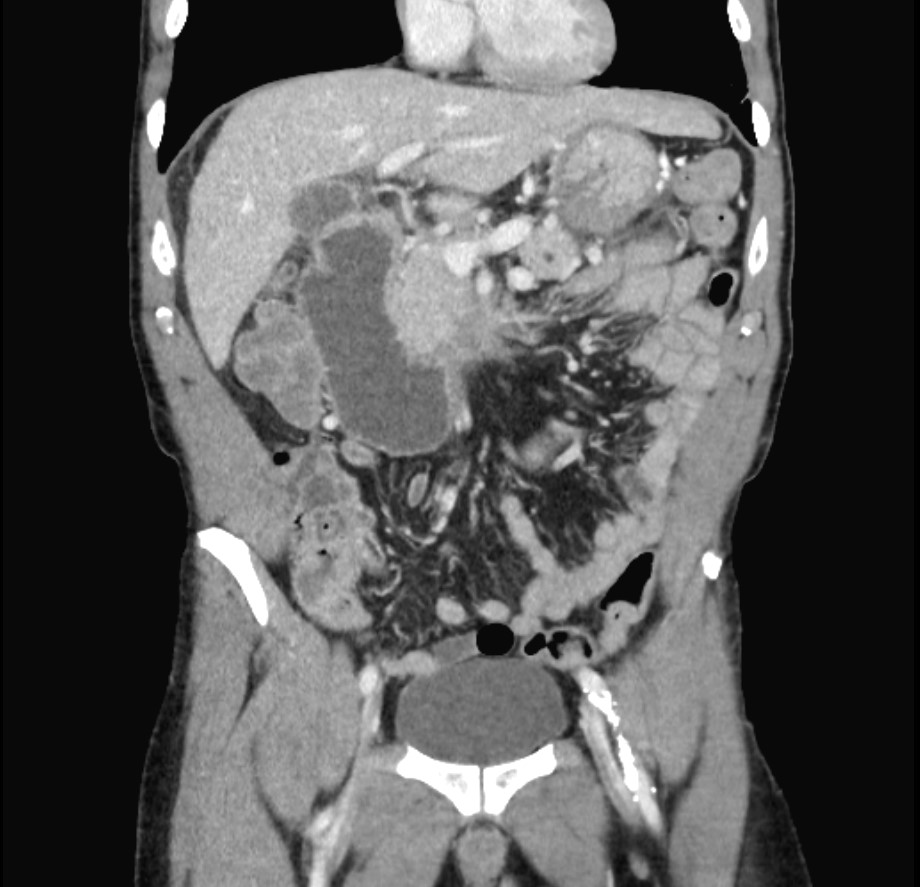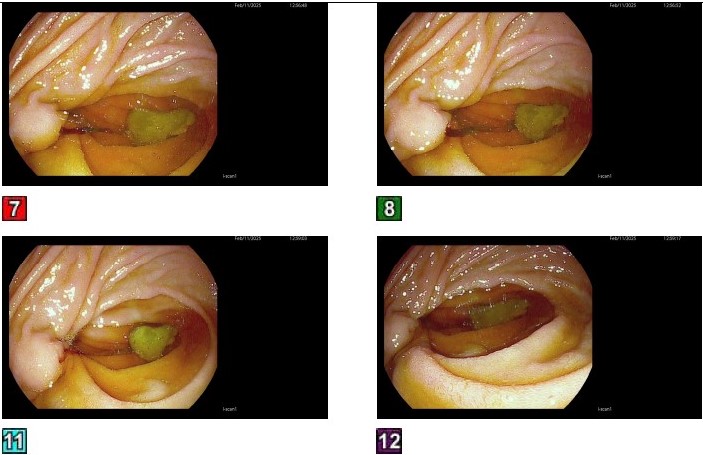Sunday Poster Session
Category: GI Bleeding
P0988 - Spontaneous Hemosuccus Pancreaticus: A Rare Cause of Bleeding From the Ampulla of Vater
Sunday, October 26, 2025
3:30 PM - 7:00 PM PDT
Location: Exhibit Hall

Rohan Karkra, MBBS
Rutgers New Jersey Medical School
Newark, NJ
Presenting Author(s)
Rohan Karkra, MBBS1, Muhammad Hassaan Arif Maan, MBBS1, Ritik M. Goyal, MBBS1, Kranthi Mandava, MD1, Ethan Shamsian, MD1, Sima Vossough-Teehan, MD2
1Rutgers New Jersey Medical School, Newark, NJ; 2East Orange VA Hospital, East Orange, NJ
Introduction: Hemosuccus pancreaticus is an extremely rare cause of upper gastrointestinal bleed characterized by bleeding from the ampulla of Vater through the pancreatic duct, which can be a result of pancreatic disease itself or related to the surrounding vasculature. Due to its infrequent, intermittent and difficult to visualize nature, it is often missed, even with EGD. In severe cases, it can also lead to hypovolemic shock. The few cases reported in literature attribute it to a history of trauma, instrumental manipulation, pseudoaneurysm rupture, infection, autoimmune disease, chronic pancreatitis, or malignancy. We describe a case of a male with chronic abdominal pain, found to have spontaneous bleeding from the ampulla of Vater on esophagogastroduodenoscopy (EGD).
Case Description/
Methods: A 68-year-old male with a history of chronic pancreatitis, portal vein thrombosis, and GERD presented with 2 months of abdominal pain, early satiety, nausea, food aversion, and constipation. Outpatient CT abdomen showed pancreatic head fullness, and evaluation with endoscopic ultrasound (EUS) was planned. During EGD, spontaneous bleeding was noted from the duodenal papilla/ampulla of Vater. Endoscopic Ultrasound (EUS) showed fullness in the pancreatic head and body. Biopsies were obtained, which were inconclusive. Triple-phase CT obtained after the procedure did not show active bleeding but again showed pancreatic and mesenteric fullness (1.7 x 3 x 2.5 cm) with mild pancreatic ductal prominence (3mm) and signs of duodenal obstruction from extrinsic compression. The patient was transferred to another hospital, where repeat EGD showed partial duodenal obstruction. EUS-guided biopsies of the pancreatic head mass this time showed moderate to poorly differentiated adenocarcinoma. An AXIOSTM stent was deployed between the stomach and jejunum to bypass the obstruction. Hematology/oncology was consulted with a plan to start neoadjuvant chemotherapy
Discussion: Hemosuccus pancreaticus is a rare condition and its awareness is lacking, leading it to often being missed. It can be an early sign of severe underlying pathology, such as malignancy, and can lead to intractable GI bleed. A high index of suspicion to make an early diagnosis and prompt intervention is key to improving patient outcomes.

Figure: CT Abdomen and Pelvis (Coronal Section) showing fullness in the pancreatic region with distension of the duodenum and some mesenteric stranding

Figure: Upper GI Endoscopy showing spontaneous bleeding from the ampulla of vater
Disclosures:
Rohan Karkra indicated no relevant financial relationships.
Muhammad Hassaan Arif Maan indicated no relevant financial relationships.
Ritik M. Goyal indicated no relevant financial relationships.
Kranthi Mandava indicated no relevant financial relationships.
Ethan Shamsian indicated no relevant financial relationships.
Sima Vossough-Teehan indicated no relevant financial relationships.
Rohan Karkra, MBBS1, Muhammad Hassaan Arif Maan, MBBS1, Ritik M. Goyal, MBBS1, Kranthi Mandava, MD1, Ethan Shamsian, MD1, Sima Vossough-Teehan, MD2. P0988 - Spontaneous Hemosuccus Pancreaticus: A Rare Cause of Bleeding From the Ampulla of Vater, ACG 2025 Annual Scientific Meeting Abstracts. Phoenix, AZ: American College of Gastroenterology.
1Rutgers New Jersey Medical School, Newark, NJ; 2East Orange VA Hospital, East Orange, NJ
Introduction: Hemosuccus pancreaticus is an extremely rare cause of upper gastrointestinal bleed characterized by bleeding from the ampulla of Vater through the pancreatic duct, which can be a result of pancreatic disease itself or related to the surrounding vasculature. Due to its infrequent, intermittent and difficult to visualize nature, it is often missed, even with EGD. In severe cases, it can also lead to hypovolemic shock. The few cases reported in literature attribute it to a history of trauma, instrumental manipulation, pseudoaneurysm rupture, infection, autoimmune disease, chronic pancreatitis, or malignancy. We describe a case of a male with chronic abdominal pain, found to have spontaneous bleeding from the ampulla of Vater on esophagogastroduodenoscopy (EGD).
Case Description/
Methods: A 68-year-old male with a history of chronic pancreatitis, portal vein thrombosis, and GERD presented with 2 months of abdominal pain, early satiety, nausea, food aversion, and constipation. Outpatient CT abdomen showed pancreatic head fullness, and evaluation with endoscopic ultrasound (EUS) was planned. During EGD, spontaneous bleeding was noted from the duodenal papilla/ampulla of Vater. Endoscopic Ultrasound (EUS) showed fullness in the pancreatic head and body. Biopsies were obtained, which were inconclusive. Triple-phase CT obtained after the procedure did not show active bleeding but again showed pancreatic and mesenteric fullness (1.7 x 3 x 2.5 cm) with mild pancreatic ductal prominence (3mm) and signs of duodenal obstruction from extrinsic compression. The patient was transferred to another hospital, where repeat EGD showed partial duodenal obstruction. EUS-guided biopsies of the pancreatic head mass this time showed moderate to poorly differentiated adenocarcinoma. An AXIOSTM stent was deployed between the stomach and jejunum to bypass the obstruction. Hematology/oncology was consulted with a plan to start neoadjuvant chemotherapy
Discussion: Hemosuccus pancreaticus is a rare condition and its awareness is lacking, leading it to often being missed. It can be an early sign of severe underlying pathology, such as malignancy, and can lead to intractable GI bleed. A high index of suspicion to make an early diagnosis and prompt intervention is key to improving patient outcomes.

Figure: CT Abdomen and Pelvis (Coronal Section) showing fullness in the pancreatic region with distension of the duodenum and some mesenteric stranding

Figure: Upper GI Endoscopy showing spontaneous bleeding from the ampulla of vater
Disclosures:
Rohan Karkra indicated no relevant financial relationships.
Muhammad Hassaan Arif Maan indicated no relevant financial relationships.
Ritik M. Goyal indicated no relevant financial relationships.
Kranthi Mandava indicated no relevant financial relationships.
Ethan Shamsian indicated no relevant financial relationships.
Sima Vossough-Teehan indicated no relevant financial relationships.
Rohan Karkra, MBBS1, Muhammad Hassaan Arif Maan, MBBS1, Ritik M. Goyal, MBBS1, Kranthi Mandava, MD1, Ethan Shamsian, MD1, Sima Vossough-Teehan, MD2. P0988 - Spontaneous Hemosuccus Pancreaticus: A Rare Cause of Bleeding From the Ampulla of Vater, ACG 2025 Annual Scientific Meeting Abstracts. Phoenix, AZ: American College of Gastroenterology.
